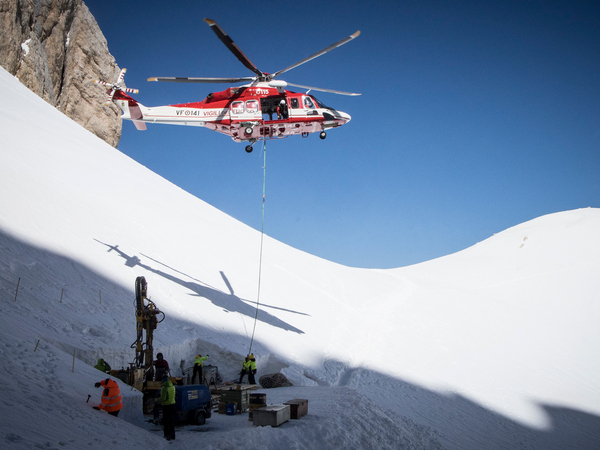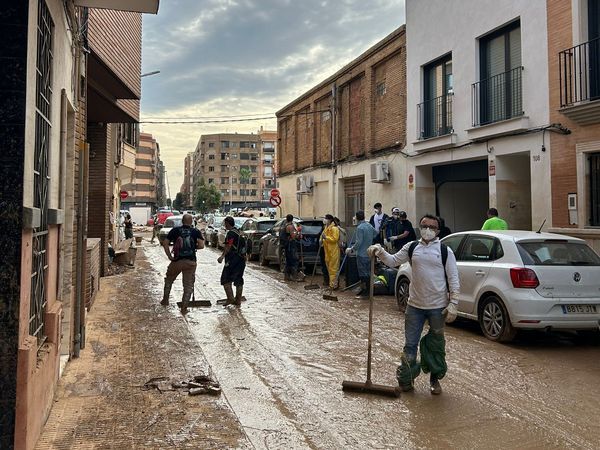The drilling campaign of the Calderone glacieret on the Gran Sasso massif has been completed. This is the first time that scientists have this type of deep ice-core sample to examine: its chemical analysis will allow them to understand the climate and environmental past of the massif and of the surrounding regions.
The mission, which is part of the international project Ice Memory, was organised by the Institute of Polar Sciences of the Italian National Research Council (CNR-ISP) and Ca’ Foscari University of Venice, in collaboration with the National Institute of Geophysics and Volcanology (Italian: Istituto Nazionale di Geofisica e Vulcanologia, INGV), the University of Padova, Georicerche Srl and Engeoneering Srls.
The expedition, which was initially hindered by unfavourable weather conditions, lasted 12 days and was made possible thanks to the collaboration of the Department of Fire Corps, Public Rescue and Civil Defence, who provided helicopters and personnel from Pescara and Roma Ciampino, trained to safely reach the ice at the foot of Corno Grande at 2,673m.
The personnel and relatively lightweight equipment was transported with an AW-139 helicopter, the core drill — which weighs 4,500 kg — was carried to the Calderone with an Erickson Air Crane S-64, the “flying crane” of the Department of Fire Corps, Public Rescue and Civil Defence, which is able to carry up to 9,000 kg. The mission was made easier by the rifugio Franchetti, which belongs to Club alpino italiano (CAI) in Rome and was opened specifically for the occasion, as well as the support of the Alpine rescue service in Abruzzo and of Comune di Pietracamela.
The core barrel touched the Gran Sasso glacieret’s sandstone at a depth of 27.2 metres, updating the estimation of 26 metres made by the team in the previous weeks, thanks to geophysical tests that allowed them to find the most promising location for drilling. “The drilling was quite difficult,” says Jacopo Gabrieli, a researcher at CNR-ISP and field coordinator of the mission, “both because of the weather conditions which were often bad, and because the ice was ‘plasticky’, i.e. extremely hot and soaked in water, so the barrel’s tip would be blocked and could not carve the surface.”
“The Department understood immediately the scientific import of the Ice Memory project,” says Laura Lega, Prefect and Head of the Department of Fire Corps, Public Rescue and Civil Defence. “This is why we promised to collaborate with CNR by providing highly-trained personnel and helicopters that would allow them to conduct complex, dangerous work at high altitude. This type of collaboration further consolidates the role that our National Corps plays in facing new challenges and supporting technologic innovation that can contribute to environmental protection. This mission does so by enabling future generations to have a ‘climate memory’ of our country, as well as highlighting the professionalism and selflessness of the Italian Fire Corps.”
Sample after sample, the researchers explored the depths of the Calderone. “Under a sheet of debris, we found ice that was increasingly ‘clean’, but that is different from Alpine glacier ice because of the peculiar thermal conditions of the various strata,” says Gabrieli. “With specific in-lab studies we will attempt to define its characteristics and acquire chemical and isotopic information, if they are available. In the middle part of the profile we found the presence of vegetation and insect residue, which can be dated to help us understand when the surrounding ice accumulated.”
“This mission was a real challenge. We did not know what we would find in the depths of the Calderone, a glacieret which loses about one metre of ice every year,” says Carlo Barbante, director of the Institute of Polar Sciences of the Italian National Research Council and professor at Ca’ Foscari University of Venice. “The ice core extracted seems to have all the right characteristics for us to draw important information regarding the climate and environmental history of central Italy and of the Mediterranean. This is a truly unique environmental archive and at a first glance we can already see very interesting glaciological characteristics.”
Once the researchers have concluded the preliminary analysis phase and verified the conservation of the stratigraphy and climate/environmental traces, the ice core will be made available for the international Ice Memory programme and therefore be moved to the storage site at Dome C, Antarctica.
The activities on the Calderone glacieret are a series of expeditions for the study and preservation of Italian glaciers, funded by the Italian Ministry of Education, University and Research, with the special supplementary fund for research, FISR. Other supporters include AKU and Karpos.











